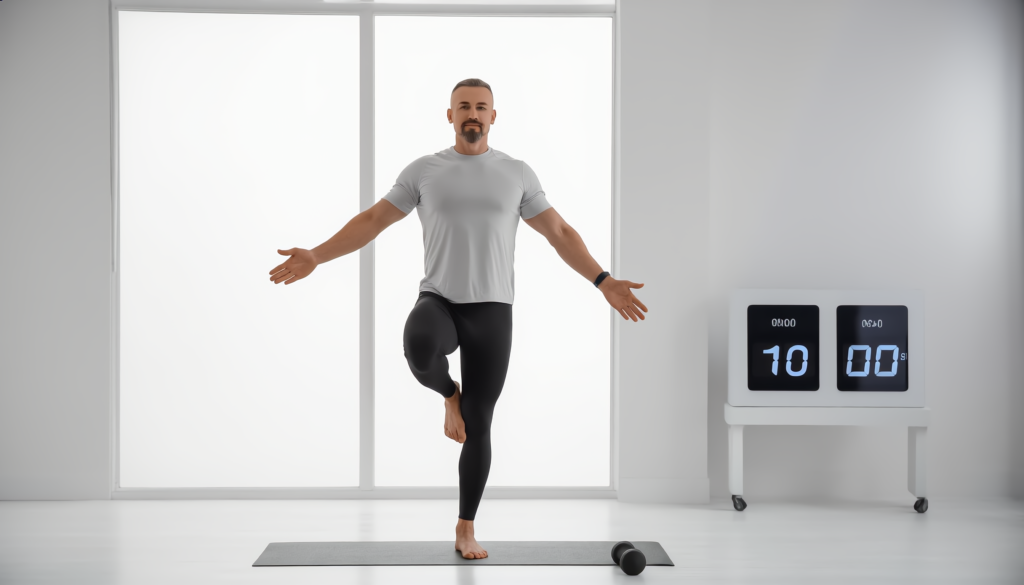Let’s play a quick game. Stand up, kick off your shoes, and try to balance on one leg for 10 seconds. No hopping, no windmilling your arms like you’re trying to take flight, and definitely no grabbing the kitchen counter for dear life. Easy, right? Or… maybe not so much.
Now, here’s the wild part: this simple “flamingo challenge” isn’t just a party trick or a way to impress your cat. According to a growing body of research, your ability to pass the 10-second balance test might just have something to say about how long you’ll live1. Yep, you read that right—your balance could be a secret window into your future health and longevity.
So, what’s the science behind this viral test? Why does balancing on one leg matter so much? And most importantly, what can you do if your wobbles outnumber your wins? Let’s take a fun, evidence-packed journey into the world of balance, aging, and the surprising ways this 10-second test could help you live longer (and steadier).
What Is the 10-Second Balance Test?
Picture this: you’re standing tall, arms by your sides, one foot off the ground, the clock ticking away. If you can hold this pose for 10 seconds, congrats—you’ve passed the famous 10-second balance test, also called the single-leg stance test.
Here’s how to do it:
- Stand near something sturdy (just in case).
- Place your arms at your sides.
- Lift one foot and rest it lightly against the back of your standing leg.
- Keep your gaze forward and try not to sway.
- Hold for 10 seconds.
You get three tries. If you make it, you’re in the “yes” group. If you wobble, hop, or have to touch down, you’re in the “no” group.
Sounds simple? Turns out, it’s trickier than it looks—especially as we age.
The Science: Why Balance Matters for Longevity
So, why does standing on one leg for 10 seconds matter? The answer lies in a fascinating study published in the British Journal of Sports Medicine in 2022. Researchers followed over 1,700 adults aged 51 to 75 for about seven years, tracking their health, fitness, and (you guessed it) their ability to balance on one leg for 10 seconds.
What Did They Find?
- About 20% of participants couldn’t hold the pose for 10 seconds.
- The older the participant, the higher the failure rate:
- Ages 51–55: 5% failed
- Ages 56–60: 8%
- Ages 61–65: 18%
- Ages 66–70: 37%
- Ages 71–75: 54% couldn’t do it
But here’s the kicker: those who failed the test were 84% more likely to die from any cause in the next decade compared to those who passed. In other words, your balance isn’t just about avoiding embarrassing falls—it’s a snapshot of your overall health.
Why the Connection?
Researchers aren’t saying the test is a magic crystal ball. Instead, it’s a powerful indicator of your body’s “behind-the-scenes” health:
- Balance reflects musculoskeletal strength, core stability, and nervous system function.
- Poor balance is linked to frailty, chronic disease (like diabetes and heart disease), and higher fall risk—all factors that can shorten lifespan.
- As we age, balance tends to decline rapidly after age 50, often before we notice other health problems.
Think of the 10-second balance test as your body’s check engine light. If you can’t do it, it’s a nudge to check in on your overall health—not a doomsday sentence!
What Else Did the Studies Show?
The research didn’t stop at “can you balance or not?” It dove deeper:
- People who couldn’t balance for 10 seconds were more likely to have higher body weight, high cholesterol, type 2 diabetes, or cardiovascular disease—regardless of age
- Every extra second you can balance reduces your risk of death by about 10%.
- The balance test adds valuable information to traditional health assessments, beyond just age, weight, or medical history.
So, if you’re over 50, this simple test could be a low-cost, at-home way to spot hidden health risks.
How to Improve Your Balance (and Maybe Your Lifespan)
Failed the test? Don’t panic! The good news is that balance can be improved at any age—and the sooner you start, the better.
Try These Balance-Boosting Tips:
- Practice the Test: Stand on one leg for 10 seconds every day. Switch legs. Challenge yourself by closing your eyes or standing on a soft surface.
- Strengthen Your Core: Planks, bridges, and yoga moves (like tree pose) help stabilize your midsection.
- Work on Leg Strength: Squats, lunges, and calf raises build the muscles that keep you upright.
- Walk Heel-to-Toe: Like you’re on a tightrope—this improves coordination and proprioception.
- Try Tai Chi or Yoga: Both are proven to boost balance and prevent falls in older adults.
- See a Pro: Physical therapists can tailor balance training to your needs, especially if you have health concerns.
Bonus: Make It Fun!
- Brush your teeth standing on one leg.
- Play balance games with kids or grandkids.
- Challenge friends or family to a “balance-off” (loser does the dishes!).
What If You Can’t Pass the Test?
If you’re struggling to balance, don’t despair. Failing the test isn’t a prophecy—it’s a prompt. Poor balance can be a sign of:
- Weak muscles or joints
- Nerve or vestibular (inner ear) issues
- Medication side effects
- Vision problems
- Underlying chronic health conditions
It’s a smart idea to mention balance issues to your doctor, especially if you’ve noticed increased falls or stumbles. Early intervention can make a huge difference.
The Bottom Line: A 10-Second Investment in Your Future
The 10-second balance test is trending for a reason: it’s quick, free, and surprisingly revealing. While it’s not a crystal ball, it’s a powerful reminder that balance is more than just a physical skill—it’s a window into your overall health and longevity.
So, next time you’re waiting for the kettle to boil or the commercials to end, give the test a try. Whether you nail it or wobble like a jellyfish, remember: balance is a skill you can train, and every second counts.
Here’s to standing tall, living long, and maybe showing off your flamingo skills at your next dinner party!
Sources:
- [Cleveland Clinic: Can the 10-Second Balance Test Predict Your Lifespan?]1
- [NBC News: 10-Second Balance Test May Predict Longevity]2
- [Paul Fischer Training: A 10-Second Balance Test As a Predictor of Longevity]3
- [PubMed: Successful 10-second one-legged stance performance predicts survival]4
- [PMC: Balance ability and all-cause death in middle-aged and older adults]5
- [IDEA Fit: The Balance and Longevity Connection]6
- [Activ8 Posture: Can You Pass The 10-Second Balance Test?]7
Ready to test your balance? Let us know how you did in the comments—and challenge a friend to join you!








